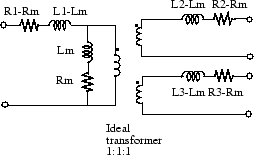Mutual Inductance
(To be removed) Implement inductances with mutual coupling
The Specialized Power Systems library will be removed in R2026a. Use the Simscape™ Electrical™ blocks and functions instead. For more information on updating your models, see Upgrade Specialized Power System Models to use Simscape Electrical Blocks.
Libraries:
Simscape /
Electrical /
Specialized Power Systems /
Passives
Description
The Mutual Inductance block can be used to model two- or three-windings inductances with equal mutual coupling, or to model a generalized multi-windings mutual inductance with balanced or unbalanced mutual coupling.
If you choose to model two- or three-windings inductances with equal mutual coupling, you specify the self-resistance and inductance of each winding plus the mutual resistance and inductance. The electrical model for this block in this case is given below:

If you choose to model a general mutual inductance, specify the number of self-windings (not just limited to 2 or 3 windings) plus the resistance and inductance matrices that define the mutual coupling relationship between the windings (balanced or not).
Equations
The resistance and inductance matrices are defined as
and
where:
R is the resistance.
R1 is the self-resistance of resistor R1.
R2 is the self-resistance of resistor R2.
Rm is the mutual resistance, such that and .
L is the inductance.
L1 is the self-inductance of inductor L1.
L2 is the self-inductance of inductor L2.
Lm is the mutual inductance, such that
Assumptions and Limitations
If you choose to model two or three windings inductances with equal mutual coupling, the following restrictions apply:
R1, R2, ..., RN ≠ RmL1, L2, ..., LN≠ Lm. (1) Negative values are allowed for the self- and mutual inductances as long as the self-inductances are different from the mutual inductance.
Windings can be left floating (not connected by an impedance to the rest of the circuit). However an internal resistor between the floating winding and the main circuit is automatically added. This internal connection does not affect voltage and current measurements.
Parameters
Extended Capabilities
Version History
Introduced before R2006a
